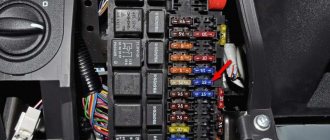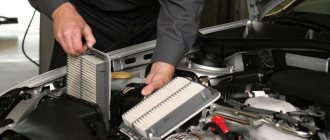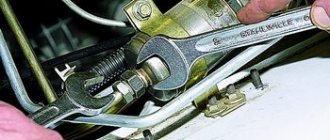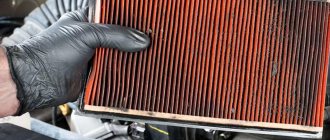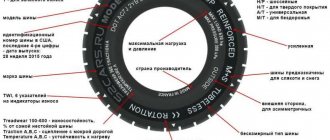03/02/2022 2,711 Fuel system
Author: Victor
The purpose of the fuel filter device in a car is to ensure high-quality cleaning of the fuel used. Once contaminants enter fuel equipment, they accumulate and can cause engine shutdown or vehicle malfunction. It is necessary to monitor the frequency of replacement of the fuel filter so that it can efficiently cope with the function of separating and retaining foreign impurities.
[Hide]
Fuel system types
Car fuel system diagram
To understand when it is necessary to change the filter device on a gasoline or diesel engine, you need to understand the types of fuel systems:
- Carburetor. These engines run on gasoline. Carburetor systems are considered obsolete and are one of the most complex in design. The purpose of the carburetor is to prepare the air-fuel mixture for the power unit. Carburetor systems have many subsystems that ensure this function is performed in different operating modes of the internal combustion engine. Despite all the disadvantages, such engines also have advantages. For example, low repair costs due to inexpensive fuel equipment components. Carburetor engines do not require the installation of high pressure pumps. The disadvantages are usually associated with ICE maintenance. Carburetor engines require constant maintenance. In the cold season, the engine must be configured correctly so that it can start without problems at low negative temperatures.
- Mono-injection. They are considered more modern systems, characterized by the presence of monophonic injection. Instead of a carburetor, it uses a spray device equipped with a single nozzle. Fuel atomization occurs when the power unit sucks in air currents. Mono-injection power systems are installed on engines running on gasoline. For optimal operation of the unit, a high pressure fuel pump and a return line are required. The system is also equipped with an engine control unit, which is used for the correct dosage of gasoline. The control module receives data from sensors of mass air flow, fuel pressure and others, as a result of which it configures the internal combustion engine for correct operation. Thanks to the use of monophonic injection, the design itself is more expensive compared to carburetor systems, but the unit starts easier at cold temperatures and is generally more stable. This allows you to reduce financial maintenance costs.
- Injection power systems with distributed injection. A more advanced engine option. Multipoint or distributor injection can be used. In such versions, the main shortcomings characteristic of older injection systems were corrected. Each cylinder of the power unit is equipped with injectors. In general, injectors have a similar principle of operation to the systems described above, but such engines are considered more environmentally friendly. Thanks to modernization, the designers managed to achieve stable operation of the unit and reduce fuel consumption; the cost of the systems was also increased.
- Injection internal combustion engines with direct injection. This type is considered one of the most perfect. In such engines, the process of atomizing the air-fuel mixture is carried out using nozzles mounted on each cylinder of the engine. Thanks to this, fuel consumption was reduced by 20% compared to systems with distributor injection. The designers were able to increase the technical parameters of the unit, including its power. The main disadvantage of such a system is its high cost, high demands on operation and the quality of the fuel being poured, as well as dependence on the use of different pumping devices. This is not just about the high pressure fuel pump.
- Diesel systems with a multi-section plunger pump. In it, fuel injection is carried out at the moment when the pump section delivers a portion of fuel. The pump itself is driven by the crank shaft. Such systems are not so demanding on the quality of the diesel fuel used, its cost is generally lower, but it is not as environmentally friendly. These systems are not equipped with a turbocharger, which can be attributed to disadvantages.
- Diesel systems with pump injectors. The advantages of improved engines include practicality and more reliable engine operation. If one of the cylinders breaks down, other devices continue to operate as usual. Each injector is equipped with its own pump, which makes it possible not to use overly long high-pressure fuel drives. But the cost of injectors is quite high, and these elements are classified as consumables, so they are also changed at certain intervals when they reach the end of their service life. Such systems are demanding on the quality of the fuel used.
- Common Rail. Such power systems are considered the most advanced; their use involves the use of a common ramp. The operating principle is similar to direct injection vehicles using gasoline. Common Rail power systems imply the presence of an electric high-pressure pumping device, with the help of which a pressure above 200 atmospheres is created in the lines. Electrical impulses supplied from the engine control unit open the injectors. The main advantages of the system include the high efficiency of the unit, reduced fuel consumption and a minimum amount of harmful substances in the exhaust gases, which makes the engines environmentally friendly. The disadvantages include the demands of engines on the quality of diesel fuel.
The ural biker channel showed how to change the fuel filter device in a Nissan Qashqai.
Summary
To operate efficiently, the engine requires high-quality and clean power. If gasoline with sand or metal scale enters the cylinders, a major overhaul is guaranteed. It is necessary to change all filters on time, and then the car will serve its owner for a long time.
Every car or truck has consumable parts that need to be replaced periodically. One of them is a filter for cleaning the fuel coming from the gas tank to the engine. The problem is this: in the car’s operating instructions, the manufacturer often indicates an interval that does not correspond to the actual service life of consumables. The condition of roads and the quality of fuels and lubricants in the CIS countries are not taken into account. In this regard, it is proposed to consider the question of how often it is necessary to change the filter element in the current operating conditions of the machines.
Car fuel filter replacement interval
Now let’s look at how often and at what mileage the filter device needs to be replaced. The exact period of operation and mileage at which the element is changed is indicated in the official regulations. To understand how often to change the filter, be sure to check the service book. Also, the replacement interval for the device depends on the conditions of use, in particular, on the quality of the fuel being poured and the dustiness of our roads.
Taking these factors into account, at least 10-15 thousand kilometers must be subtracted from the filter service life indicated by the manufacturer. If the service manual states that the device will operate for 40 thousand km, then it is recommended to replace it after 25-30 thousand. Experts advise replacing the fuel filter every 20-25 thousand km, regardless of when the car manufacturer recommends doing so. Some Ford and Nissan models are equipped with maintenance-free filters, the service life of which is equal to the service life of the car. The manufacturer Nissan has established a replacement interval of 10 thousand km for car brands equipped with serviceable filters.
How often to change a diesel filter
As for the service life of cleaning elements for such power units, they are lower when compared with analogues for gasoline.
Automakers officially recommend replacement every 30 thousand kilometers for imported engines, and even then only if the fuel is of high quality. And in the case of domestic fuel, this period can be divided into three. By and large, the car itself will tell you by its behavior when to change the fuel filter. This will be the most correct frequency.
Causes of malfunctions
In what cases is it necessary to change the filter element:
- If it becomes clogged and has expired its service life.
- If the power system was repaired, and during the process some of its components were removed.
- If dirt and other foreign substances, for example, additives, have entered the gas tank and have a negative impact on the operation of the power unit. When the fuel lines are washed, a new filter must be installed.
- As a preventive measure before a long trip over a long distance.
- If you have been refueling with low-quality fuel for a long time, which has led to problems with the engine.
Find out what the filter device looks like in cross-section after 10 thousand km of run from the video filmed by the TEXaS TV channel.
What does the filter protect against?
It's no secret that the fuel at our gas stations is not of high quality. Gasoline contains sand, rust, metal scale - all this settles on the filter. If these substances get into the engine, the main parts will wear out much faster.
As a result, the owner will need major repairs. In addition, oxidized sulfur, or rather sulfuric acid, which is formed during the combustion process, has a detrimental effect on metal surfaces. A normally functioning fuel filter completely captures various dirt and dust, condensation, rust, and paraffin inclusions. A dirty element must not be used. And if the car owner is wondering whether to change the fuel filter or clean the old one, it definitely needs to be changed. If you ignore the regulations, problems with your car will not take long to appear. Stable engine starting will be disrupted, and damage to various elements of the injection system is possible. A clogged element leads to carburetor clogging, increased fuel consumption, and a drop in engine power.
Signs of a clogged filter
Briefly about the symptoms that indicate the filter device is not working:
- The car's power unit began to work unevenly. The internal combustion engine “troits”, its speed either drops or increases.
- From time to time, especially when driving uphill, the car’s engine loses power and its traction decreases. To make up for power, the driver has to press the gas harder.
- If the car drives uphill at low speeds, the engine may stall. In this case, pressing the gas pedal will not produce results.
- If the car is equipped with an automatic transmission, then problems may arise in shifting gears. This is due to the fact that the internal combustion engine incorrectly transmits commands from the engine and shifts gears at the wrong time.
- Fuel consumption increases.
Why in winter?
Here's why. The water that accumulates in the separator freezes at low air temperatures.
This does not have the best effect on the flow of fuel. And instead of winter diesel intended for winter, they like to purchase summer compounds. And in this summer solarium, paraffin is released at low temperatures. This is what clogs the filters.
Experienced car owners carry an additional spare element with them in winter so that if the old one is clogged, they can quickly install a new one.
Replacing the fuel filter
Recommendations and instructions on how to properly replace the filter device are given below.
Required Tools
Before you begin the process, prepare the following:
- the filter itself;
- wrenches, their sizes depend on the design features of the car;
- flathead and Phillips head screwdrivers;
- rags.
The Auto Repair channel provided a video in which it showed the process of replacing a filter device using the example of a Chevrolet Lacetti.
Step-by-step instruction
The replacement process in a car running on gasoline or diesel will differ depending on where the filter is installed. The device can be located under the bottom of the car or in the engine compartment. If the filter is maintenance-free, it is installed together with the fuel pump. Let's consider the replacement process for each case.
Without fuel pump
If the TF is installed not in the fuel pump, but independently, the replacement procedure is carried out as follows:
- Locate the device located under the vehicle or in the engine compartment.
- Open the fuse box and remove the part responsible for engine operation. Start the engine and wait until it stops. This means that the fuel system has been depressurized.
- Determine the type of fixation of the fuel device to the line. For fastening, manufacturers use bolts, self-tapping screws, a hose with clamps, or special latches. Depending on the type of fixation, remove the filter. To do this, you can disconnect the latches, loosen the clamps on the pipes, unscrew the bolts or screws, after wrapping the device in rags. When disconnecting the filter, some fuel will come out, be careful. After dismantling the part, evaluate the condition of the gaskets and seals, if any. Worn sealing components must be replaced.
- Install a new filter, taking into account the direction of the fuel along the line. It is important not to make a mistake here so as not to disrupt the operation of the engine. The arrow on the filter housing indicates the direction of fuel supply.
- Reconnect the fuel line and check its condition. If damaged, the hoses must be replaced.
- Replace the safety element of the pump device. Start the engine. Due to the release of pressure, it may be difficult to do this the first time, but after a few attempts to start everything will work out. Perform a test drive and check the condition of the filter. If there is a leak, correct the problem.
1. Unscrew the bolts securing the device to the line
2. Install the new filter and securely fix it
Complete with fuel pump
If the filter is maintenance-free, but it is still clogged, car manufacturers recommend replacing the fuel pump assembly.
But to save money, you can replace the filter itself, the role of which in pumping devices is played by a special mesh:
- The fuel pump is mounted in the fuel tank. You can access it by removing the rear seat and opening a special hatch that is secured with bolts. Some cars, for example, Ford Focus, may not have a sunroof. Then the car owner will have to dismantle the fuel tank.
- Open the fuse box and remove the device responsible for the operation of the pump. Start the engine and wait until it stops.
- Opening the hatch, you will see the fuel pump cover. You need to disconnect the connectors from the wires connected to it, and then dismantle all the pipes.
- Unscrew the cap and remove the fuel pump.
- The filter mesh is located inside the device. The dismantling procedure depends on the design features of the machine; usually it does not cause difficulties. To disassemble the pump, unscrew all the bolts and remove its elements to gain access to the mesh.
- Once the screen is removed, do not attempt to clean it. Many car enthusiasts think that cleaning with water pressure will allow them to use the mesh a second time. After washing, it can actually work for some time, but usually this is not for long. Replace the mesh and reassemble the pumping device. Reinstall it, connect all disconnected pipes and connectors. Replace the fuse and start the engine.
Description
The purpose of the fuel filter (FF) is to filter out dust particles and contaminants and prevent them from entering the engine fuel system. In the absence of a cleaning element in the system, dust and other harmful components clog and damage the fuel system.
Cross-section of the fuel filter: 1 - filter element for injection cars, 2 - its housing
The filtration process consists of two or more degrees of purification (depending on the structure of the filter and its production). The first degree is called coarse, because it manages to filter out large particles of dirt that entered the gas tank along with the fuel. The second is a fine filter, which is located somewhere between the gas tank and the vehicle’s engine (this “somewhere” can be in different places, depending on the car).
Filters vary in their design. They are installed based on the type of fuel system. There are three types:
- carburetor;
- injection;
- diesel
The specificity of diesel filters is that this type of engine is very vulnerable, so the fuel for the systems must be as clean as possible. In this case, the car’s fuel undergoes three stages of purification - in the gas tank, and then coarse and fine cleaning. The purpose of a diesel engine fuel filter is to prevent water from entering the combustion chamber. If you take these factors into account, it becomes clear why a high-quality TF for a diesel car costs an order of magnitude more than a cleaning element for a gasoline engine.
Diesel TF: 1 - diesel, 2 - pump emulsion, 3 - dirt removal, 4 - clean fuel with condensate residue, 5 - hydrophobic material, 6 - moisture separator
By design, filters can be of two types: prefabricated and non-removable. If a non-separable gasoline cleaning component is installed in a car, then if it is unsuitable, the fuel filter is completely replaced. Prefabricated TFs do not require a complete change—it is enough to replace the filter element.
Remember: a properly selected TF specifically for the car model will save fuel and increase the frequency of its replacement. If the component replacement process is not done in a timely manner, the consequences for the fuel system can be disastrous.
If you don’t know where the fuel filter is located and how often it is changed, read the operating instructions. We can say that in most diesel and carburetor cars the filter is located in the engine compartment. Gasoline purification components in injection cars are located under the bottom of the car (if the filter is not dismountable) or under the rear seat. In this case, the TF is located directly in the fuel pump and replacing it involves replacing the fuel pump mesh.
Injection fuel filters are not subject to corrosion because they are made of aluminum or plastic alloys.
Collapsible TF
Video “Visual instructions for replacing the filter”
Using the Ford Focus car as an example, the Service Guide channel offers to familiarize yourself with the procedure for changing the filter device.
Do you have any questions? Specialists and readers of the AUTODVIG website will help you ask a question
Was this article helpful?
Thank you for your opinion!
The article was useful. Please share the information with your friends.
Yes (100.00%)
No
X
Please write what is wrong and leave recommendations on the article
Cancel reply
Rate this article: ( 2 votes, average: 5.00 out of 5)
Discuss the article:
Signs and causes of premature clogging
While driving, symptoms of contamination of the mesh elements often appear, by which you can determine when to change the fuel filter. They look like this:
- it is difficult to start the engine “cold” - the fuel pump needs more time to increase the pressure in the system;
- when trying to accelerate dynamically, a “failure” is observed - the car slowly picks up speed due to a banal lack of fuel;
- the same phenomenon occurs when driving with increased load - uphill, with a trailer or with a maximum number of passengers;
- after sharply releasing the accelerator pedal, the engine does not go to idle and stalls.
The reason for this behavior of the car is premature blockage. The malfunction occurs when constantly driving on dusty roads or refueling with low-quality fuel.
A separate point regarding separators on diesel engines: if you pour summer diesel fuel without additives into the tank during the cold season, the mesh and water separator may become covered with a film of paraffin. In such a situation, the fuel filter must be changed without delay.
If you ignore the symptoms listed above or simply do not install a new consumable part on time, then the dirt, along with water, breaks further to the power unit. This is fraught with the following consequences:
- On carburetor engines, foreign particles clog the smallest holes in the fuel path. These are the idle jet and the calibrated economizer hole. Later, the main fuel jets also become clogged. Signs: increased gas mileage and engine reluctance to idle.
- On injection and diesel engines, injectors suffer. Deposits form in the valve part, causing increased wear. If ultrasonic or other cleaning is not performed on time, the injectors will leak and poorly spray the air-fuel mixture into the cylinders. Symptoms are very difficult hot starts and high fuel consumption.
- Water or condensate getting into diesel cylinders can lead to costly repairs. The fact is that the combustion chambers of these engines are small, and the pressure in the cylinders is high. The presence of incompressible fluid in the chamber can lead to water hammer and cracks in the cylinder head.
Note. Leaking injectors must be replaced; cleaning them will not help. The price of parts, especially for diesel engines, is quite high. It’s easier to change the filter element 5–10 thousand km ahead of schedule.
If you need to change the filter due to premature contamination, which manifests itself in unstable engine operation, then debris has probably gotten into the carburetor or injectors. In the first case, it is advisable to blow out the idle jet (it is unscrewed from the outside), and in the second, visit a car service center to wash the nozzles.
How to determine if the cleaning element is clogged
If you do not promptly replace such a fuel system cleaning element, you may encounter quite serious problems. But the process of clogging a part does not happen suddenly, everything happens gradually. If you know what the signs are that the filter needs replacing, many problems can be avoided.
The most common signs of blockage are:
- Unstable operation of the power unit (“sneezing” and the like);
- Low power level compared to what it was before;
- Increased fuel consumption compared to the norm. Although a clogged cleaning element does not directly affect this, it is still the original cause.
It is worth noting that in the initial stages of clogging, such problems do not appear clearly, which is basically why all the problems arise. But experienced drivers are able to replace everything in time and take appropriate measures.
With the most serious blockages, it may not even be possible to start the engine. If the situation gets to this point, quite serious and expensive repairs may be required.
